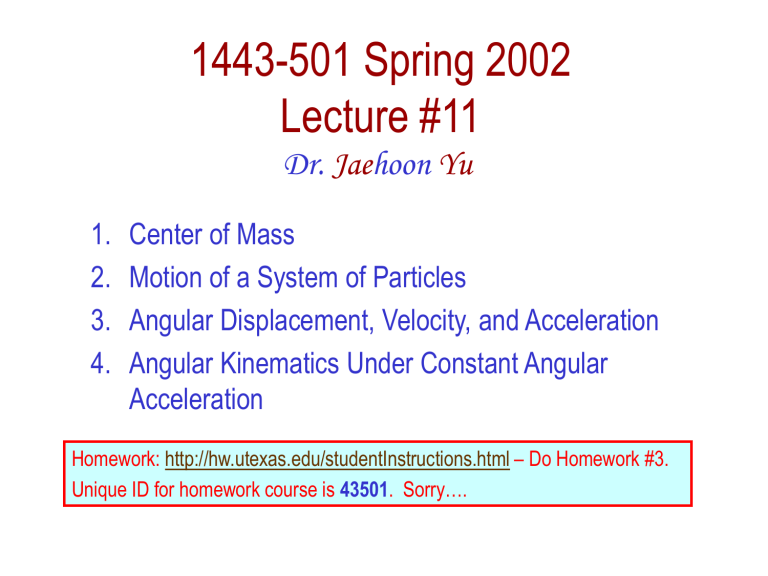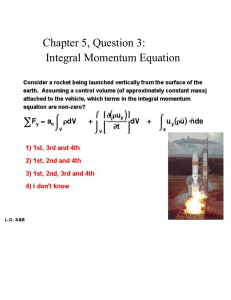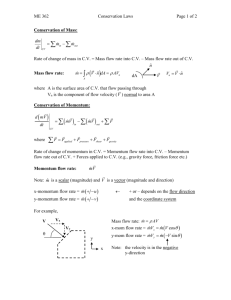Wednesday, Feb. 27, 2002

1443-501 Spring 2002
Lecture #11
Dr. Jae hoon Yu
1. Center of Mass
2. Motion of a System of Particles
3. Angular Displacement, Velocity, and Acceleration
4. Angular Kinematics Under Constant Angular
Acceleration
Homework: http://hw.utexas.edu/studentInstructions.html
– Do Homework #3.
Unique ID for homework course is 43501 . Sorry….
Homework Assignment Pickup and Submission
1. Go to the URL https://hw.utexas.edu/roster.html and register yourself as a student by providing the information requested.
Please keep your username and password well. The unique ID for the class is 43501 and there is no password assigned for this class.
2. Click “OK” button at the bottom of the page
3. Provide your username and password again in the new page brought up.
4. Once 1-3 is done, go to the “Student Login” page at URL https://hw.utexas.edu/index.html
and log into the page by providing your username and password again.
5. You can pick up the home work by clicking on the button #2.1.
1.
You need to print it out to work on the homework problems.
2.
Solutions will be available after the due dates (1 week). The button
#2.2 is solution pick up.
6. After the completion you can submit the homework by clicking on the button #3.1
Feb. 27, 2002 1443-501 Spring 2002
Dr. J. Yu, Lecture #11
2
m
1
Collisions in Two Dimension
In two dimension, one can use components of momentum to apply momentum conservation to solve physical problems.
v
1i f q m
2 m
1 v
1 i
m
2 v
2 i
m
1 v
1 f
m
2 v
2 f m
1 v
1 ix m
1 v
1 iy
m
2 v
2 ix
m
2 v
2 iy
m
1 v
1 fx
m
1 v
1 fy
m
2 v
2 fx
m
2 v
2 fy
Consider a system of two particle collisions and scatters in two dimension as shown in the picture. (This is the case at fixed target accelerator experiments.) The momentum conservation tells us: m
1 v
1 i
m
2 v
2 i
m
1 v
1 i m
1 v
1 ix m
1 v
1 iy
m
1 v
1 fx
0
m
2 v
2 fx m
1 v
1 fy
m
1 v
1 f m
2 v
2 fy
cos m
1 v
1 f q m
2 v
2 f sin q cos m
2 v
2 f f sin f
And for the elastic conservation, the kinetic energy is conserved:
1
2 m
1 v
1 i
2
1
2 m
1 v
1
2 f
1
2 m
2 v
2
2 f
Feb. 27, 2002 1443-501 Spring 2002
Dr. J. Yu, Lecture #11
3
Example 9.9
A 1500kg car traveling east with a speed of 25.0 m/s collides at an interaction with a 2500kg van traveling north at a speed of 20.0 m/s. After the collision the two cars stuck to each other, and the wreckage is moving together. Determine the velocity of the wreckage after the collision, assuming the vehicles underwent a perfectly inelastic collision.
The initial momentum of the two car system before the collision is p i
m
1 v
1 i i
m
2 v
2 i j
1500
25 .
0 i
2500
20 .
0 j
3 .
75
10
4 i
5 .
0
10
4 j
Using momentum conservation
Feb. 27, 2002
The final momentum of the two car system after the perfectly p inelastic collision is f
m
1
m
2
v fx i
v fy j
4 .
0
10
3 v fx i
4 .
0
10
3 v fy j p
f p i v fx
3 .
75
10
4
1500
2500
9 .
38 m
5 .
0
10
4 v fy
1500
1443-501 Spring 2002 v f
2500
9 .
38 i
12 .
5 m
12 .
5 j
m /
Dr. J. Yu, Lecture #11 s
/
/ s s
4
Center of Mass
We’ve been solving physical problems treating objects as sizeless points with masses, but in realistic situation objects have shapes with masses distributed throughout the body.
Center of mass of a system is the average position of the system’s mass and represents the motion of the system as if all the mass is on the point.
What does above statement tell you concerning forces being exerted on the system?
m
1 x
1
Feb. 27, 2002 x
CM m
2 x
2
The total external force exerted on the system of total mass M causes the center of mass to move at
the mass of the system is concentrated on the center of mass.
Consider a massless rod with two balls attached at either end.
The position of the center of mass of this system is the mass averaged position of the system x
CM
m
1 x
1 m
1
m
2 m
2 x
2
CM is closer to the heavier object
1443-501 Spring 2002
Dr. J. Yu, Lecture #11
5
Center of Mass of a Rigid Object
x
CM
The formula for CM can be expanded to Rigid Object or a system of many particles
m
1 x
1 m
1
m
2 m x
2
2
m m n n x n
i
i m i m i x i y
CM
i
i m i m i y i
; z
CM
i
i m i m i z i r i
The position vector of the center of mass of a many particle system is r
CM
m i
Feb. 27, 2002 r
CM
i
x
CM m i x i i i
y
CM j
i m i
i y i m i
j z
CM
i k m i z i k
A rigid body – an object with shape and size with mass spread throughout the body, ordinary objects – can be considered as a group of particles with mass m densely spread throughout i the given shape of the object
1443-501 Spring 2002
Dr. J. Yu, Lecture #11 x
CM x
CM r
CM
i m i x i
M
lim
m i
0
i
m i x i
M
1
M
i m i r i
M
1
M r dm
6
xdm
Center of Mass and Center of Gravity
CM
The center of mass of any symmetric object lies on an axis of symmetry and on any plane of symmetry, if object’s mass is evenly distributed throughout the body.
How do you think you can
Axis of
One can use gravity to locate CM.
symmetry
1. Hang the object by one point and draw a vertical line determine the CM of following a plum-bob.
objects that are not symmetric?
2. Hang the object by another point and do the same.
3. The point where the two lines meet is the CM.
Center of Gravity
Since a rigid object can be considered as collection of small masses, one can see the total gravitational force exerted on the object as
m i
m i g
What does this equation tell you?
F g
i
F i
i
m i g
M g
The net effect of these small gravitational forces is equivalent to a single force acting on a point ( Center of Gravity ) with mass M.
Feb. 27, 2002 1443-501 Spring 2002
Dr. J. Yu, Lecture #11
7
Example 9.12
A system consists of three particles as shown in the figure. Find the position of the center of mass of this system.
y=2 m
1
(0,2) r
CM
(0.75,4)
(1,0) m
2 x=1
(2,0) m
3 x=2
Using the formula for CM for each position vector component x
CM
i
m i m i x i i
One obtains x
CM y
CM
i
m i m i x i
i i
i m i m i y i
m
1 x
1 m
1 m
2 m x
2
2
m m
3
3 x
3 m
1 y
1 m
1 m
2
m y
2
2
m m
3
3 y
3
m m
2
1
m
2
2 m
3
m
3 m
1
2 m
1 m
2
m
3
Feb. 27, 2002 1443-501 Spring 2002
Dr. J. Yu, Lecture #11
; y
CM r
CM
If
i
m i m i y i i
m
2
m
1
2 m
3
m
2 i
2 m
1 m
3 j m
1
2 kg ; m
2
m
3
1 kg r
CM
3 i
4 j
4
0 .
75 i
j
8
Example 9.13
Show that the center of mass of a rod of mass M and length L lies in midway between its ends, assuming the rod has a uniform mass per unit length.
x
L dx dm= l dx
The formula for CM of a continuous object is x
CM
1
M
x x
0
L xdm
Since the density of the rod is constant, one can write dm
l dx
; where
l
M
/
L
Therefore x
CM
1
M
x x
0
L l xdx
1
M
1
2 l x
2
x
L x
0
1
M
1
2 l
L
2
1
M
1
2
ML
L
2
Find the CM when the density of the rod non-uniform but varies linearly as a function of x, la x
M
x x
0
L l dx
1
2 a x
2
x x
Feb. 27, 2002
0
L
x x
0
L a xdx
1
2 a
L
2 x
CM
1
M
x
x
0
L l xdx
1
M
x x
0
L a x
2 dx
1
M
1
3 a x
3
x
L x
0
1
M
1 a
L
3
1
3 M
1443-501 Spring 2002
Dr. J. Yu, Lecture #11
2
3
ML
2 L
3
9
Motion of a Group of Particles
We’ve learned that the CM of a system can represent the motion of a system.
Therefore, for an isolated system of many particles in which the total mass
M is preserved, the velocity, total momentum, acceleration of the system are
Velocity of the system v
CM
d r
CM dt
d dt
1
M
m i r i
1
M
m i d r i dt
m i v i
M
Total Momentum of the system
Acceleration of the system p tot
M v
CM
M
m i v i
M
m i v i
p i a
CM
d v
CM dt
d dt
1
M
m i v i
1
M
m i d v i dt
m i a i
M
External force exerting on the system
If net external force is 0
Feb. 27, 2002
F ext
M a
CM
m i a i
d p tot dt
F ext
0
d p tot ; p tot dt
1443-501 Spring 2002
Dr. J. Yu, Lecture #11
const
What about the internal forces?
System’s momentum is conserved.
10
Rocket Propulsion
What is the biggest difference between ordinary vehicles and a rocket?
The force that gives propulsion for normal vehicles is the friction between the surface of the road and the tire . The system in this case consists of the tire and the surface of the road. Newton’s 3 rd law and the momentum conservation of an isolated system.
Since there is no road to push against, the rockets obtain propulsion from momentum conservation in the system consists of the rocket and gas from burnt fuel. v
M+ m Initial momentum before burning fuel v
v
m g v+
v
M
From momentum conservation
Initial momentum after burning fuel and ejecting the gas
M v
v
g
M v p
M
p v
M
v
m v ; M
v
m
v
m v
m v g g
Since dm is the same as
–dM, one can obtain d v
dm v g
M
; i
f d v
v f
v i
v g i
f dM
M
v g ln
M
M f i
Thrust is the force exerted on the rocket by the ejected gas
Thurst
M dv
v g dM dt dt
11 Feb. 27, 2002 1443-501 Spring 2002
Dr. J. Yu, Lecture #11
v
v g
m
Example 9.18
A rocket moving in free space has a speed of 3.0x10
3 m/s relative to the Earth. Its engines are turned on, and fuel is ejected in a direction opposite the rocket’s motion at a speed of 5.0x10
3 m/s relative to rocket. A) What is the speed of the rocket relative to the Earth once its mass is reduced to one-half the mass before ignition?
v
M+ m v+
v
M
Precisely the case we’ve discussed in the previous slide.
v f
v i
v g ln
M i
M f
3 .
0
10
3
5 .
0
10
3 ln
6 .
5
10
3 m / s
Find the thrust on the rocket if it burns fuel at the rate of 50kg/s?
Since the thrust is given proportional to the rate of mass change or the rate the fuel burns as given in the formula
One can obtain
Thurst
M dv
v g dM dt dt
Thurst
v g dM dt
5 .
0
10
5 m / s
50 kg / s
2 .
5
10
7
N
Feb. 27, 2002 1443-501 Spring 2002
Dr. J. Yu, Lecture #11
12





